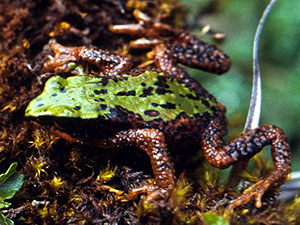Onore’s Stub-foot Toad was described in 2007, it is so far known only from the two localities in the Azuay Basin in the Cordillera Occidental in Ecuador, where it was discovered in 1990.
The species was photographed alive, the ground color of most individuals was orange-yellow, the dorsal areas of the males were variably colored bright green. The most conspicuous character of this species, however, were the aqua-blue colored iris of their eyes.
Onore’s Stub-foot Toad was never found again since its discovery and is believed to be already extinct.
*********************
References:
[1] Luis A. Coloma; Stefan Lötters; William E. Duellman; Alfonso Miranda-Leiva: A taxonomic revision of Atelopus pachydermus, and description of two new (extinct?) species of Atelopus from Ecuador (Anura: Bufonidae). Zootaxa 1557: 1-32. 2007
*********************
edited: 07.05.2019

